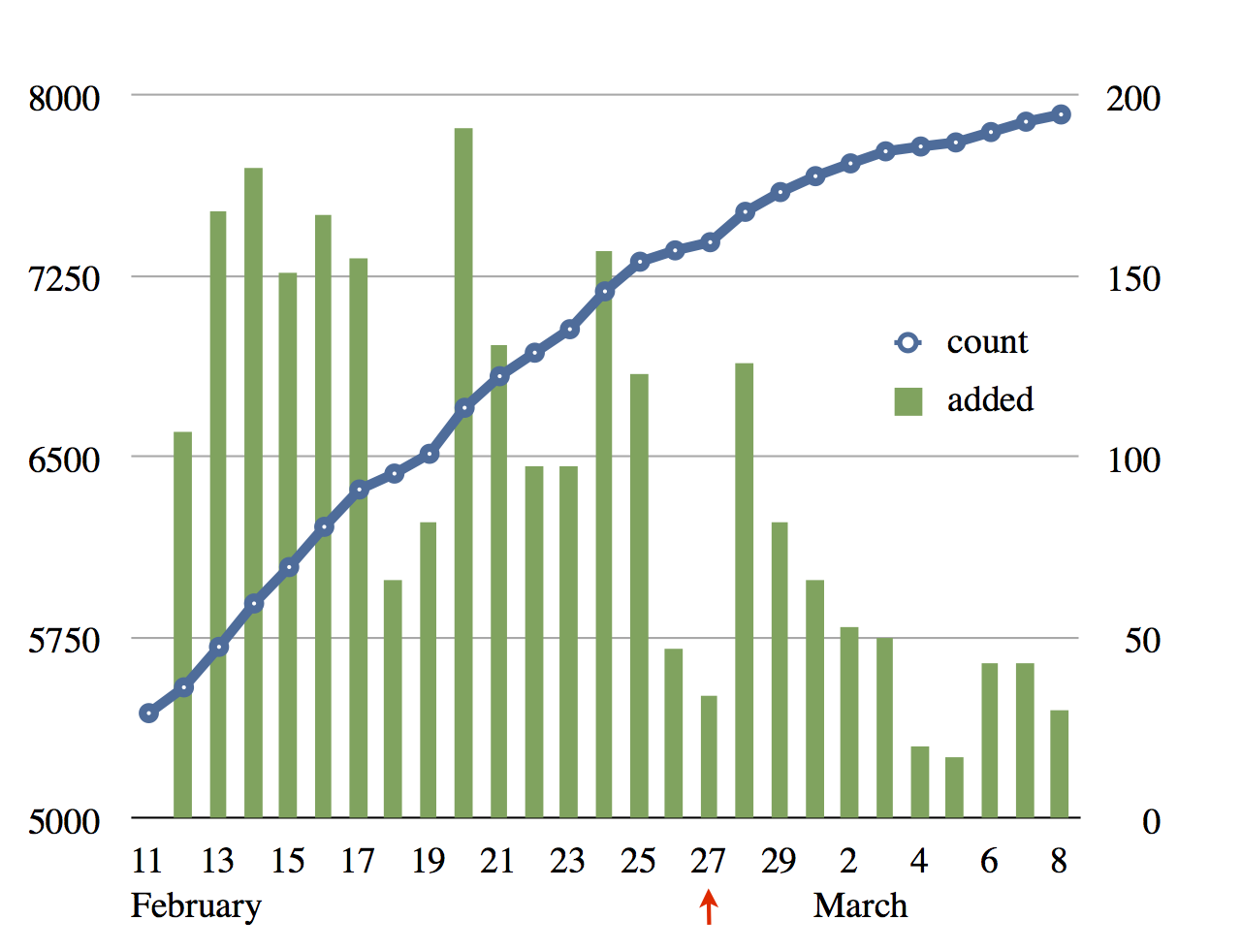Statement before the House Science Committee
March 30th, 2012
 |
| “Majesty of Law” Statue in front of the Rayburn House Office Building in Washington, D.C., photo by flickr user NCinDC, used by permission (CC-by-nd) |
Here is my written testimony filed in association with my appearance yesterday at the hearing on “Federally Funded Research: Examining Public Access and Scholarly Publication Interests” before the Subcommittee on Investigations and Oversight of the House Committee on Science, Space and Technology. My thanks to Chairman Broun, ranking member Tonko, and the committee for allowing me the opportunity to speak with them today.
[Update 3/30/12: Coverage from Chronicle of Higher Education. Update 4/2/12: Video of the session is available from the House Science Committee as well.]
Read the rest of this entry »
The “Cost of Knowledge” boycott trajectory
March 8th, 2012
 |
| “Have scientists lost interest again?” |
The “Cost of Knowledge” boycott of Elsevier is in its seventh week. The boycott was precipitated by various practices of the journal publisher, most recently its support for the Research Works Act, a bill that would roll back the NIH public access policy and prevent similar policies by other federal funding agencies.
Early on, several hundred researchers a day were signing on to the pledge not to submit to or edit or review for Elsevier journals, but recently that rate had settled down to about a hundred per day. On February 11, I started tracking the daily totals by scraping the site through a simple scraper I set up at ScraperWiki. I’ve graphed the results in the attached graph, showing raw count of signatories with the blue line (left axis) and the number added since the previous day with the green bars (right axis).
As you can see from the chart, there seems to be a slight drop in activity around weekends, and Sunday February 26 and Monday February 27 had clearly been the slowest days since I’ve been keeping records, and likely since the effort started. On the 27th (red arrow), Elsevier issued its quasi-recantation of support for RWA. (“While we continue to oppose government mandates in this area, Elsevier is withdrawing support for the Research Work Act itself. We hope this will address some of the concerns expressed….”)
The day after Elsevier’s announcement saw a bit of a bump back to previous levels. Was this an instance of the Streisand effect or was the 26-27 dip an aberration? It’s hard to tell. However, since the 27th, it seems clear that the number of pledges is down considerably. It could well be that Elsevier’s tactical approach has worked and it has stanched the spate of boycott pledges, despite the fact that the community was generally unimpressed with Elsevier’s statement, as Peter Suber has cataloged. Alternatively, the current rate of new pledges may just reflect the natural reductions that had been happening over the last few weeks.
Elsevier has not changed its underlying stance. It still “continue[s] to oppose government mandates” for public access, as per RWA. It strongly opposes FRPAA. Have scientists lost interest again?
 |
| “Note the surges…” |
[Update 4/20/2012: Now that a few more weeks have passed, here’s an updated figure of the boycott growth. Note the surges around March 18 and April 10. As near as I can make out, these were the result of widely disseminated coverage in Slashdot and the Guardian, respectively. These surges show that the boycott hasn’t played itself out yet, and that continued discussion of the boycott is likely to lead to a continued steady rise in the number of signatures.
At the current rate, I expect the number of signatories to hit 10,000 around April 27 or so.]
[Update 4/24/2012: Well, my guess was wrong. A big bump of activity in the last few days meant that the boycott broke 10,000 signatures on April 23. I’m not sure who to blame for the renewed interest in the last couple of days. Anyone have any conjectures?]
An efficient journal
March 6th, 2012
 |
| “You seem to believe in fairies.” Photo of the Cottingley Fairies, 1917, by Elsie Wright via Wikipedia. |
Aficionados of open access should know about the Journal of Machine Learning Research (JMLR), an open-access journal in my own research field of artificial intelligence, a subfield of computer science concerned with the computational implementation and understanding of behaviors that in humans are considered intelligent. The journal became the topic of some dispute in a conversation that took place a few months ago in the comment stream of the Scholarly Kitchen blog between computer science professor Yann LeCun and scholarly journal publisher Kent Anderson, with LeCun stating that “The best publications in my field are not only open access, but completely free to the readers and to the authors.” He used JMLR as the exemplar. Anderson expressed incredulity:
I’m not entirely clear how JMLR is supported, but there is financial and infrastructure support going on, most likely from MIT. The servers are not “marginal cost = 0” — as a computer scientist, you surely understand the 20-25% annual maintenance costs for computer systems (upgrades, repairs, expansion, updates). MIT is probably footing the bill for this. The journal has a 27% acceptance rate, so there is definitely a selection process going on. There is an EIC, a managing editor, and a production editor, all likely paid positions. There is a Webmaster. I think your understanding of JMLR’s financing is only slightly worse than mine — I don’t understand how it’s financed, but I know it’s financed somehow. You seem to believe in fairies.
Since I have some pretty substantial knowledge of JMLR and how it works, I thought I’d comment on the facts of the matter. Read the rest of this entry »